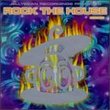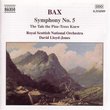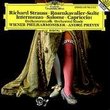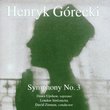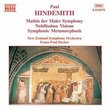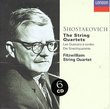| All Artists: Ralph Vaughan Williams, Kees Bakels, Bournemouth Sinfonietta, Bournemouth Symphony Orchestra, Patricia Rozario Title: Vaughan Williams: Symphonies Nos. 3 "Pastoral" & No. 6 Members Wishing: 0 Total Copies: 0 Label: Naxos Original Release Date: 1/1/1994 Re-Release Date: 10/4/1994 Genre: Classical Styles: Historical Periods, Modern, 20th, & 21st Century, Symphonies Number of Discs: 1 SwapaCD Credits: 1 UPC: 730099573320 |
Search - Ralph Vaughan Williams, Kees Bakels, Bournemouth Sinfonietta :: Vaughan Williams: Symphonies Nos. 3 "Pastoral" & No. 6
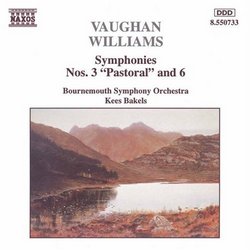 | Ralph Vaughan Williams, Kees Bakels, Bournemouth Sinfonietta Vaughan Williams: Symphonies Nos. 3 "Pastoral" & No. 6 Genre: Classical
|
Larger Image |
CD DetailsSimilar CDs
Similarly Requested CDs
|
CD ReviewsA Vaughan Williams Discovery (Symphonies Nos. 1 & 3) Thomas F. Bertonneau | Oswego, NY United States | 10/19/2000 (5 out of 5 stars) "On the surface, the Third (1922) and Sixth (1947) Symphonies by Ralph Vaughan Williams (1872-1958) could not contrast more starkly. Subtitled "Pastoral," the Third appears to exemplify the notion of "English music" as a low-key celebration of rural lifeways and folk-song in dialect; the rather more abstract Sixth seems to be the eruptive reaction of an aging philosopher to the state of perpetual, institutionalized war ("Cold War") that followed the victory over Germany and Japan in 1945. The Third undulates quietly in minor modes while the Sixth explodes with dissonance and violence. Consider, however, the fourth-movement Finales of both symphonies: Each proceeds quietly, rarely rising above "piano" in the dynamic indications; both equivocate between major and minor and ultimately seem to revert to minor mode. Vaughan Williams made it clear that the Finale of the Third commemorated his service in the Ambulance Corps in France in World War I, and can certainly strike the listener as elegiac in tone; commentators imputed to the Finale of the Sixth the notion that it depicted a world blasted and depopulated by atomic weapons. Vaughan Williams denied this, but only by quoting Prospero's oblique acknowledgment of mortality from Shakespeare's "The Tempest": "We are such stuff as dreams are made on and our little life is rounded in a sleep." In fact, the Third and Sixth Symphonies belong to a single aesthetic, one in which the salient event is the disappearance of old ways of life having to do with the immemorial rhythms of the countryside. It makes sense, then, to couple these two symphonies, as Kees Bakels has done in his Naxos survey of the Vaughan Williams symphonies. The benchmarks against which new recorded performances must compete are the recordings by Sir Adrian Boult, who set down the Sixth as early as 1949 and made the first recording of the "Pastoral" in the early 1950s. Bakels has a more supple way with these scores than Boult, who could be wiry and stiff (although powerful and forthright). As the Boult interpretations become scarce, Bakels' newer, better sounding, and considerably less expensive readings become more attractive. His Third is lean and modern and yet movingly nostalgic when the wordless soprano joins the orchestra in the Finale. He calculates the performance to deemphasize the work's association with gentler scores like the "Norfolk Rhapsody" or "The Lark Ascending." Bakels' Sixth, while slower in the First Movement than the original 1949 recording under Boult, manages to be even more bellicose and cataclysmic. Save for the Finale, all of movements take longer under Bakels than under Boult, but this results in no slackening of the tension. Fine performances in fine sound." Beautiful Pastoral Symphony Tim Hawkins | Rochester, NY USA | 02/07/2008 (5 out of 5 stars) "Naxos has produced a vibrant recording in the form of two Vaughan Williams Symphonies - No. 3 and No. 6. To start, the sixth symphony on this CD sounds great, and is a testimony to Vaughan Williams more dissonant style. In complete contrast is the third, or "Pastoral," symphony. It is here where the orchestra really impresses. The strings are very well-balanced and stunning with their timbres and nuances. Delicate woodwinds accompany the strings, along with distant brass. Overall, this recording truly manifests itself on every level of Vaughan Williams musical purposes. The program of both these symphonies on one disc displays musical contrast, an excellent notion when it comes to discovering a composer's different styles. Overall, this album is highly recommended both on an artistic level and a production level."
|

 Track Listings (8) - Disc #1
Track Listings (8) - Disc #1
